HYUNDAI VELOSTER N 2022 Owners Manual
Manufacturer: HYUNDAI, Model Year: 2022, Model line: VELOSTER N, Model: HYUNDAI VELOSTER N 2022Pages: 446, PDF Size: 9.71 MB
Page 261 of 446
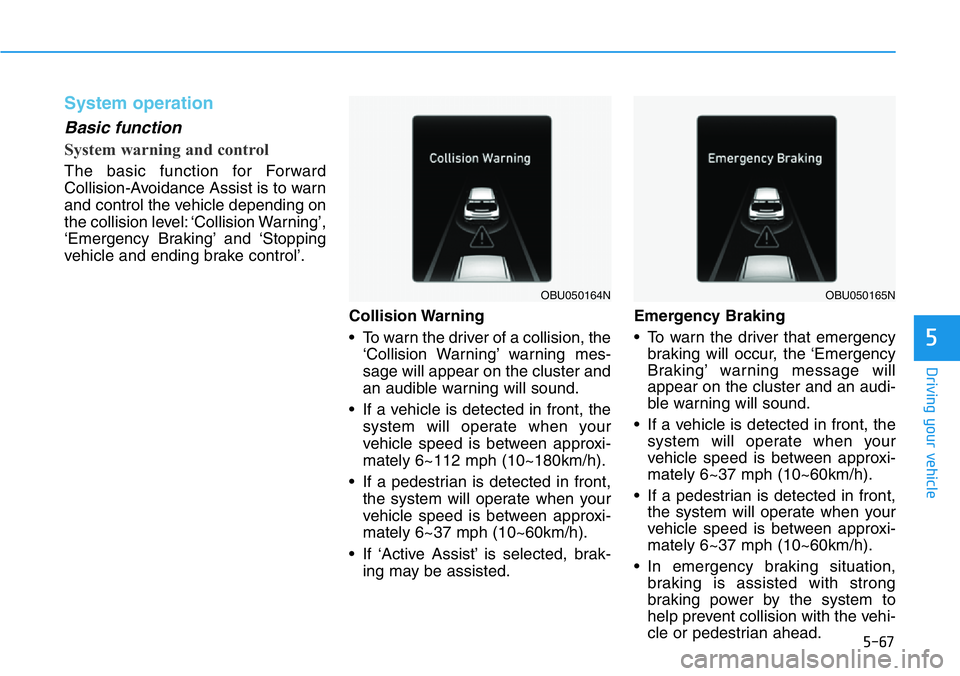
5-67
Driving your vehicle
5
System operation
Basic function
System warning and control
The basic function for Forward
Collision-Avoidance Assist is to warn
and control the vehicle depending on
the collision level: ‘Collision Warning’,
‘Emergency Braking’ and ‘Stopping
vehicle and ending brake control’.
Collision Warning
• To warn the driver of a collision, the
‘Collision Warning’ warning mes-
sage will appear on the cluster and
an audible warning will sound.
• If a vehicle is detected in front, the
system will operate when your
vehicle speed is between approxi-
mately 6~112 mph (10~180km/h).
• If a pedestrian is detected in front,
the system will operate when your
vehicle speed is between approxi-
mately 6~37 mph (10~60km/h).
• If ‘Active Assist’ is selected, brak-
ing may be assisted.Emergency Braking
• To warn the driver that emergency
braking will occur, the ‘Emergency
Braking’ warning message will
appear on the cluster and an audi-
ble warning will sound.
• If a vehicle is detected in front, the
system will operate when your
vehicle speed is between approxi-
mately 6~37 mph (10~60km/h).
• If a pedestrian is detected in front,
the system will operate when your
vehicle speed is between approxi-
mately 6~37 mph (10~60km/h).
• In emergency braking situation,
braking is assisted with strong
braking power by the system to
help prevent collision with the vehi-
cle or pedestrian ahead.
OBU050164NOBU050165N
Page 262 of 446
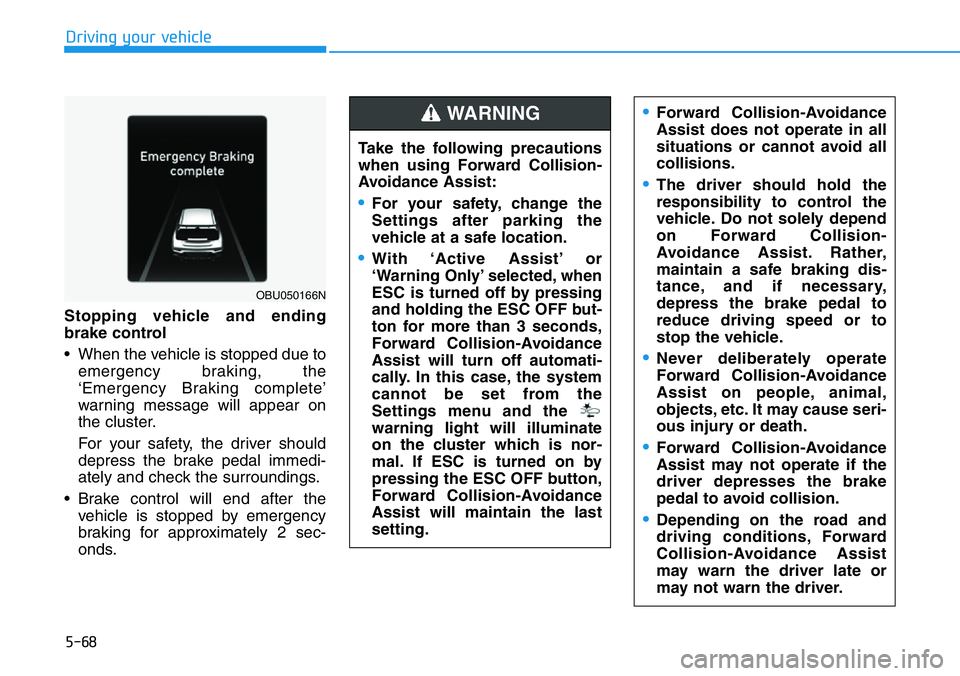
5-68
Driving your vehicle
Stopping vehicle and ending
brake control
• When the vehicle is stopped due to
emergency braking, the
‘Emergency Braking complete’
warning message will appear on
the cluster.
For your safety, the driver should
depress the brake pedal immedi-
ately and check the surroundings.
• Brake control will end after the
vehicle is stopped by emergency
braking for approximately 2 sec-
onds.
OBU050166N
Take the following precautions
when using Forward Collision-
Avoidance Assist:
•For your safety, change the
Settings after parking the
vehicle at a safe location.
•With ‘Active Assist’ or
‘Warning Only’ selected, when
ESC is turned off by pressing
and holding the ESC OFF but-
ton for more than 3 seconds,
Forward Collision-Avoidance
Assist will turn off automati-
cally. In this case, the system
cannot be set from the
Settings menu and the
warning light will illuminate
on the cluster which is nor-
mal. If ESC is turned on by
pressing the ESC OFF button,
Forward Collision-Avoidance
Assist will maintain the last
setting.
WARNING •Forward Collision-Avoidance
Assist does not operate in all
situations or cannot avoid all
collisions.
•The driver should hold the
responsibility to control the
vehicle. Do not solely depend
on Forward Collision-
Avoidance Assist. Rather,
maintain a safe braking dis-
tance, and if necessary,
depress the brake pedal to
reduce driving speed or to
stop the vehicle.
•Never deliberately operate
Forward Collision-Avoidance
Assist on people, animal,
objects, etc. It may cause seri-
ous injury or death.
•Forward Collision-Avoidance
Assist may not operate if the
driver depresses the brake
pedal to avoid collision.
•Depending on the road and
driving conditions, Forward
Collision-Avoidance Assist
may warn the driver late or
may not warn the driver.
Page 263 of 446
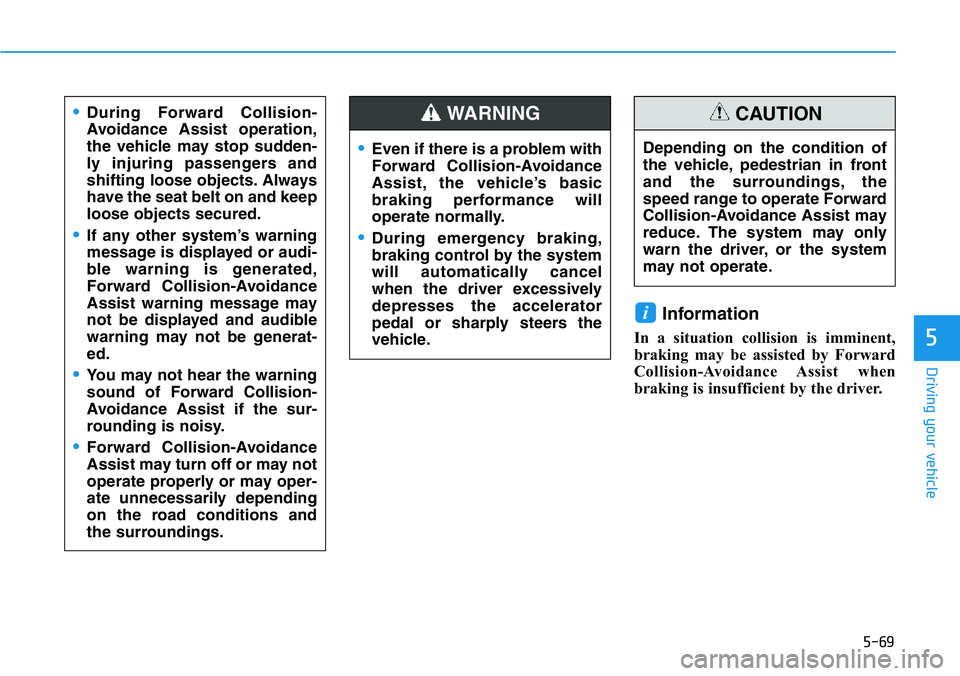
5-69
Driving your vehicle
5
Information
In a situation collision is imminent,
braking may be assisted by Forward
Collision-Avoidance Assist when
braking is insufficient by the driver.
i
•During Forward Collision-
Avoidance Assist operation,
the vehicle may stop sudden-
ly injuring passengers and
shifting loose objects. Always
have the seat belt on and keep
loose objects secured.
•If any other system’s warning
message is displayed or audi-
ble warning is generated,
Forward Collision-Avoidance
Assist warning message may
not be displayed and audible
warning may not be generat-
ed.
•You may not hear the warning
sound of Forward Collision-
Avoidance Assist if the sur-
rounding is noisy.
•Forward Collision-Avoidance
Assist may turn off or may not
operate properly or may oper-
ate unnecessarily depending
on the road conditions and
the surroundings.
•Even if there is a problem with
Forward Collision-Avoidance
Assist, the vehicle’s basic
braking performance will
operate normally.
•During emergency braking,
braking control by the system
will automatically cancel
when the driver excessively
depresses the accelerator
pedal or sharply steers the
vehicle.
WARNING
Depending on the condition of
the vehicle, pedestrian in front
and the surroundings, the
speed range to operate Forward
Collision-Avoidance Assist may
reduce. The system may only
warn the driver, or the system
may not operate.
CAUTION
Page 264 of 446
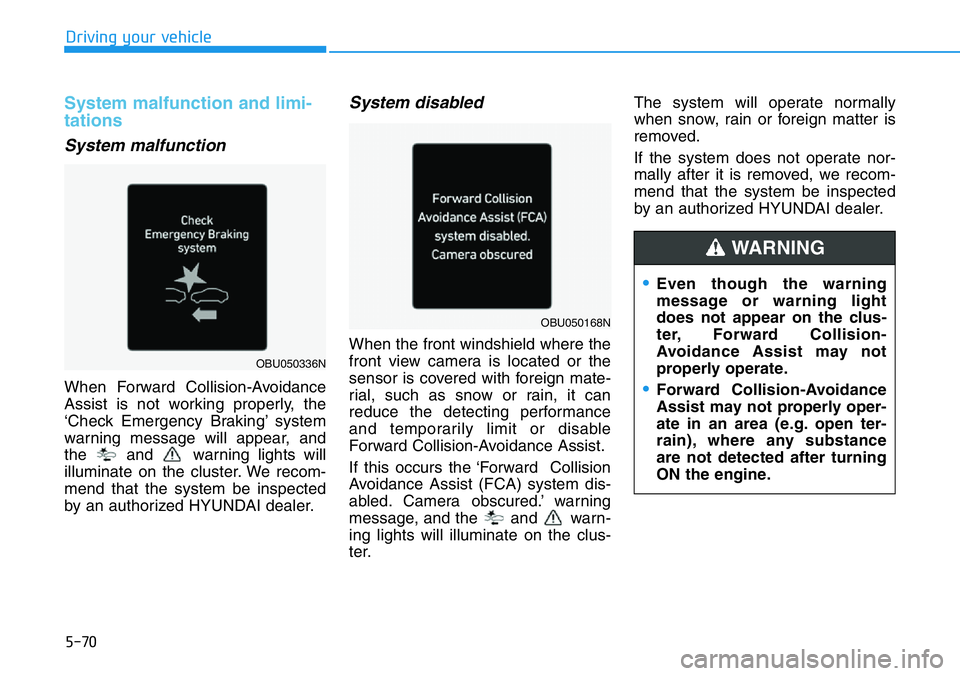
5-70
Driving your vehicle
System malfunction and limi-
tations
System malfunction
When Forward Collision-Avoidance
Assist is not working properly, the
‘Check Emergency Braking’ system
warning message will appear, and
the and warning lights will
illuminate on the cluster. We recom-
mend that the system be inspected
by an authorized HYUNDAI dealer.
System disabled
When the front windshield where the
front view camera is located or the
sensor is covered with foreign mate-
rial, such as snow or rain, it can
reduce the detecting performance
and temporarily limit or disable
Forward Collision-Avoidance Assist.
If this occurs the ‘Forward Collision
Avoidance Assist (FCA) system dis-
abled. Camera obscured.’ warning
message, and the and warn-
ing lights will illuminate on the clus-
ter.The system will operate normally
when snow, rain or foreign matter is
removed.
If the system does not operate nor-
mally after it is removed, we recom-
mend that the system be inspected
by an authorized HYUNDAI dealer.
•Even though the warning
message or warning light
does not appear on the clus-
ter, Forward Collision-
Avoidance Assist may not
properly operate.
•Forward Collision-Avoidance
Assist may not properly oper-
ate in an area (e.g. open ter-
rain), where any substance
are not detected after turning
ON the engine.
WARNING
OBU050336N
OBU050168N
Page 265 of 446
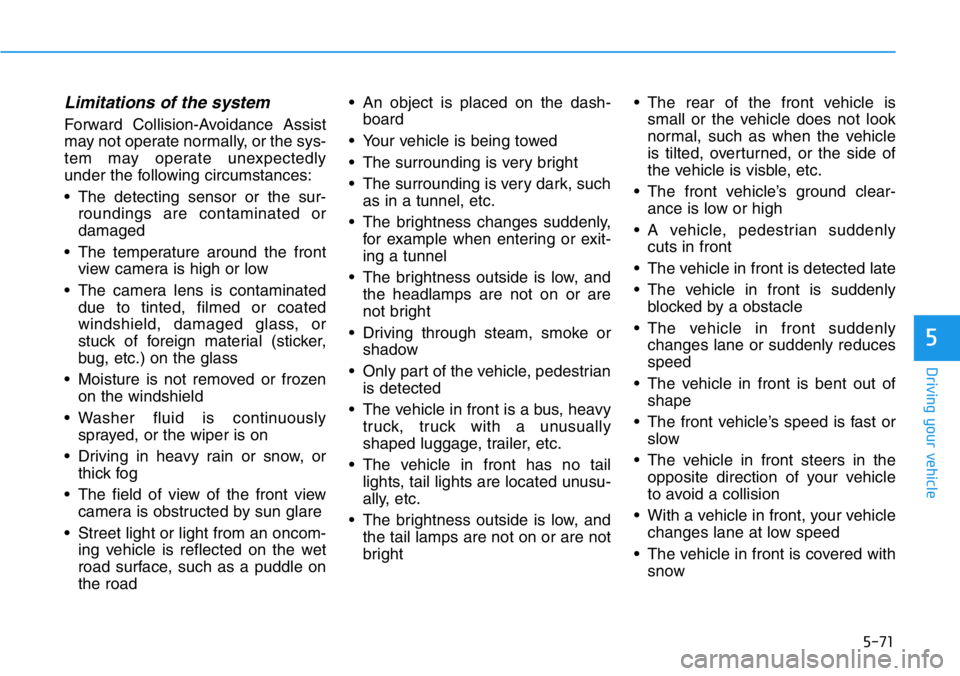
5-71
Driving your vehicle
5
Limitations of the system
Forward Collision-Avoidance Assist
may not operate normally, or the sys-
tem may operate unexpectedly
under the following circumstances:
• The detecting sensor or the sur-
roundings are contaminated or
damaged
• The temperature around the front
view camera is high or low
• The camera lens is contaminated
due to tinted, filmed or coated
windshield, damaged glass, or
stuck of foreign material (sticker,
bug, etc.) on the glass
• Moisture is not removed or frozen
on the windshield
• Washer fluid is continuously
sprayed, or the wiper is on
• Driving in heavy rain or snow, or
thick fog
• The field of view of the front view
camera is obstructed by sun glare
• Street light or light from an oncom-
ing vehicle is reflected on the wet
road surface, such as a puddle on
the road• An object is placed on the dash-
board
• Your vehicle is being towed
• The surrounding is very bright
• The surrounding is very dark, such
as in a tunnel, etc.
• The brightness changes suddenly,
for example when entering or exit-
ing a tunnel
• The brightness outside is low, and
the headlamps are not on or are
not bright
• Driving through steam, smoke or
shadow
• Only part of the vehicle, pedestrian
is detected
• The vehicle in front is a bus, heavy
truck, truck with a unusually
shaped luggage, trailer, etc.
• The vehicle in front has no tail
lights, tail lights are located unusu-
ally, etc.
• The brightness outside is low, and
the tail lamps are not on or are not
bright • The rear of the front vehicle is
small or the vehicle does not look
normal, such as when the vehicle
is tilted, overturned, or the side of
the vehicle is visble, etc.
• The front vehicle’s ground clear-
ance is low or high
• A vehicle, pedestrian suddenly
cuts in front
• The vehicle in front is detected late
• The vehicle in front is suddenly
blocked by a obstacle
• The vehicle in front suddenly
changes lane or suddenly reduces
speed
• The vehicle in front is bent out of
shape
• The front vehicle’s speed is fast or
slow
• The vehicle in front steers in the
opposite direction of your vehicle
to avoid a collision
• With a vehicle in front, your vehicle
changes lane at low speed
• The vehicle in front is covered with
snow
Page 266 of 446
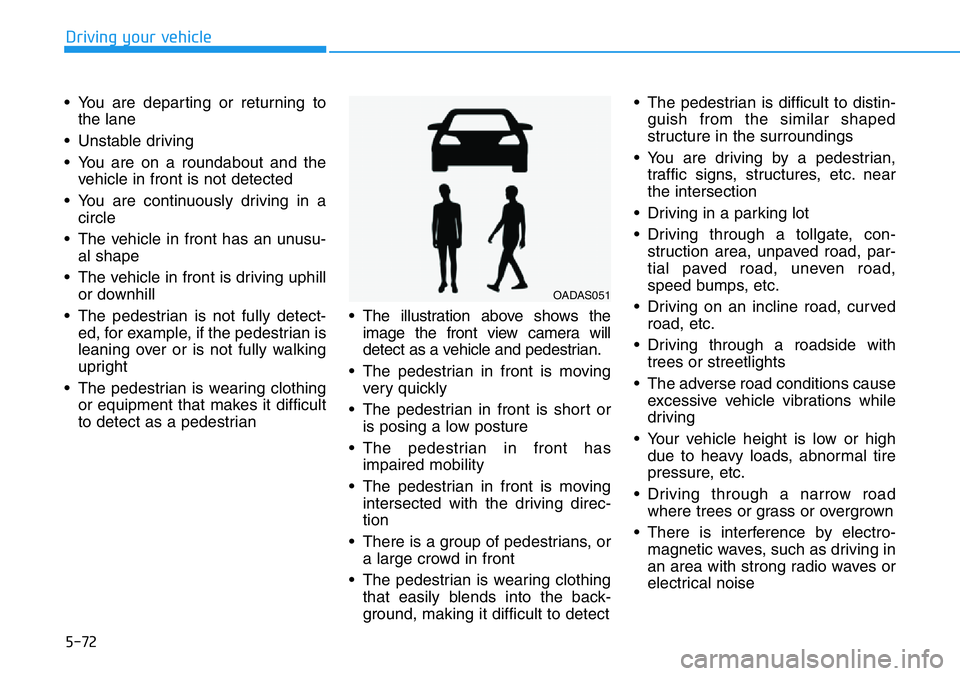
5-72
Driving your vehicle
• You are departing or returning to
the lane
• Unstable driving
• You are on a roundabout and the
vehicle in front is not detected
• You are continuously driving in a
circle
• The vehicle in front has an unusu-
al shape
• The vehicle in front is driving uphill
or downhill
• The pedestrian is not fully detect-
ed, for example, if the pedestrian is
leaning over or is not fully walking
upright
• The pedestrian is wearing clothing
or equipment that makes it difficult
to detect as a pedestrian• The illustration above shows the
image the front view camera will
detect as a vehicle and pedestrian.
• The pedestrian in front is moving
very quickly
• The pedestrian in front is short or
is posing a low posture
• The pedestrian in front has
impaired mobility
• The pedestrian in front is moving
intersected with the driving direc-
tion
• There is a group of pedestrians, or
a large crowd in front
• The pedestrian is wearing clothing
that easily blends into the back-
ground, making it difficult to detect• The pedestrian is difficult to distin-
guish from the similar shaped
structure in the surroundings
• You are driving by a pedestrian,
traffic signs, structures, etc. near
the intersection
• Driving in a parking lot
• Driving through a tollgate, con-
struction area, unpaved road, par-
tial paved road, uneven road,
speed bumps, etc.
• Driving on an incline road, curved
road, etc.
• Driving through a roadside with
trees or streetlights
• The adverse road conditions cause
excessive vehicle vibrations while
driving
• Your vehicle height is low or high
due to heavy loads, abnormal tire
pressure, etc.
• Driving through a narrow road
where trees or grass or overgrown
• There is interference by electro-
magnetic waves, such as driving in
an area with strong radio waves or
electrical noise
OADAS051
Page 267 of 446
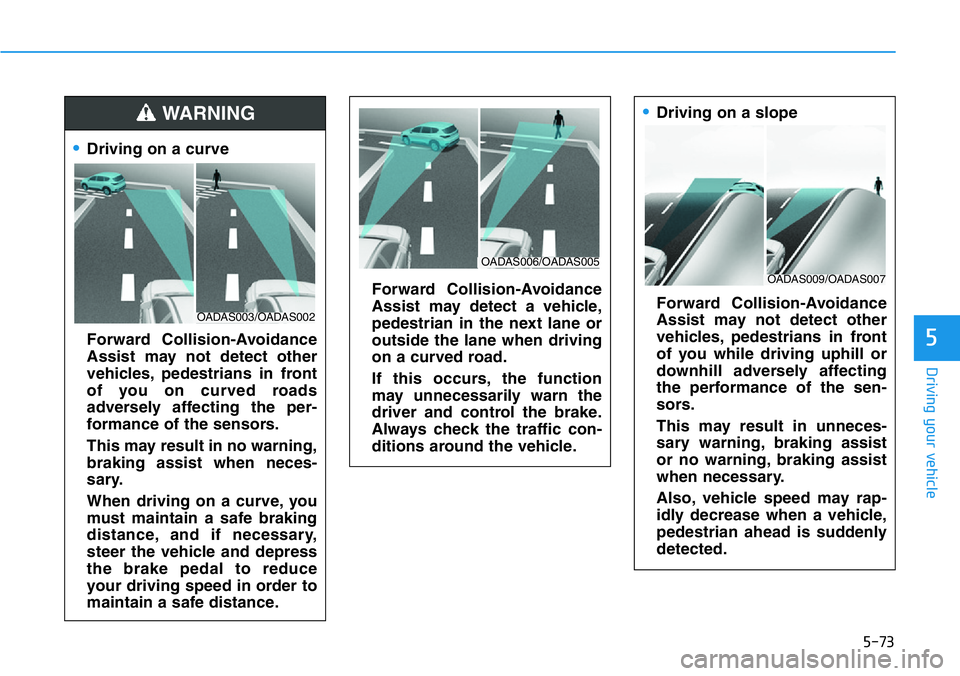
5-73
Driving your vehicle
5
•Driving on a curve
Forward Collision-Avoidance
Assist may not detect other
vehicles, pedestrians in front
of you on curved roads
adversely affecting the per-
formance of the sensors.
This may result in no warning,
braking assist when neces-
sary.
When driving on a curve, you
must maintain a safe braking
distance, and if necessary,
steer the vehicle and depress
the brake pedal to reduce
your driving speed in order to
maintain a safe distance.
Forward Collision-Avoidance
Assist may detect a vehicle,
pedestrian in the next lane or
outside the lane when driving
on a curved road.
If this occurs, the function
may unnecessarily warn the
driver and control the brake.
Always check the traffic con-
ditions around the vehicle.
•Driving on a slope
Forward Collision-Avoidance
Assist may not detect other
vehicles, pedestrians in front
of you while driving uphill or
downhill adversely affecting
the performance of the sen-
sors.
This may result in unneces-
sary warning, braking assist
or no warning, braking assist
when necessary.
Also, vehicle speed may rap-
idly decrease when a vehicle,
pedestrian ahead is suddenly
detected.WARNING
OADAS003/OADAS002
OADAS009/OADAS007
OADAS006/OADAS005
Page 268 of 446
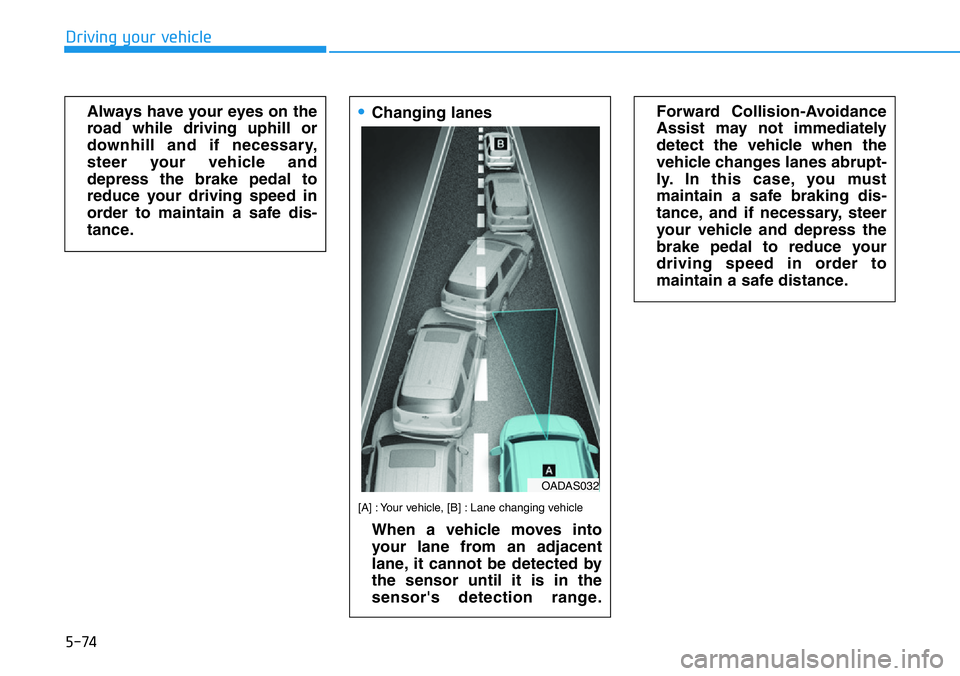
5-74
Driving your vehicle
Always have your eyes on the
road while driving uphill or
downhill and if necessary,
steer your vehicle and
depress the brake pedal to
reduce your driving speed in
order to maintain a safe dis-
tance.
•Changing lanes
[A] : Your vehicle, [B] : Lane changing vehicle
When a vehicle moves into
your lane from an adjacent
lane, it cannot be detected by
the sensor until it is in the
sensor's detection range.
Forward Collision-Avoidance
Assist may not immediately
detect the vehicle when the
vehicle changes lanes abrupt-
ly. In this case, you must
maintain a safe braking dis-
tance, and if necessary, steer
your vehicle and depress the
brake pedal to reduce your
driving speed in order to
maintain a safe distance.
OADAS032
Page 269 of 446
![HYUNDAI VELOSTER N 2022 Owners Manual 5-75
Driving your vehicle
5
[A] : Your vehicle, [B] : Lane changing vehicle,
[C] : Same lane vehicle
When a vehicle in front of you
merges out of the lane,
Forward Collision-Avoidance
Assist may not HYUNDAI VELOSTER N 2022 Owners Manual 5-75
Driving your vehicle
5
[A] : Your vehicle, [B] : Lane changing vehicle,
[C] : Same lane vehicle
When a vehicle in front of you
merges out of the lane,
Forward Collision-Avoidance
Assist may not](/img/35/41174/w960_41174-268.png)
5-75
Driving your vehicle
5
[A] : Your vehicle, [B] : Lane changing vehicle,
[C] : Same lane vehicle
When a vehicle in front of you
merges out of the lane,
Forward Collision-Avoidance
Assist may not immediately
detect the vehicle that is now
in front of you.
In this case, you must main-
tain a safe braking distance,
and if necessary, steer your
vehicle and depress the brake
pedal to reduce your driving
speed in order to maintain a
safe distance.
•Detecting vehicle
If the vehicle in front of you
has cargo that extends rear-
ward from the cab, or when
the vehicle in front of you has
higher ground clearance,
additional special attention is
required. Forward Collision-
Avoidance Assist may not be
able to detect the cargo
extending from the vehicle.
In these instances, you must
maintain a safe braking dis-
tance from the rearmost
object, and if necessary, steer
your vehicle and depress the
brake pedal to reduce your
driving speed in order to
maintain distance.
OADAS033
OBU050217N
Page 270 of 446

5-76
Driving your vehicle
Information
This device complies with Part 15 of
the FCC rules.
Operation is subject to the following
two conditions:
1. This device may not cause harmful
interference.
2. This device must accept any inter-
ference received, including interfer-
ence that may cause undesired
operation.
i
•When you are towing a trailer
or another vehicle, we recom-
mend that Forward Collision-
Avoidance Assist is turned off
due to safety reasons.
•Forward Collision-Avoidance
Assist may operate if objects
that are similar in shape or
characteristics to vehicles
and pedestrians are detected.
•Forward Collision-Avoidance
Assist does not operate on
bicycles, motorcycles, or
smaller wheeled objects, such
as luggage bags, shopping
carts, or strollers.
•Forward Collision-Avoidance
Assist may not operate nor-
mally if interfered by strong
electromagnetic waves.
•Forward Collision-Avoidance
Assist may not operate for 15
seconds after the vehicle is
started, or the front view cam-
era is initialized.
WARNING